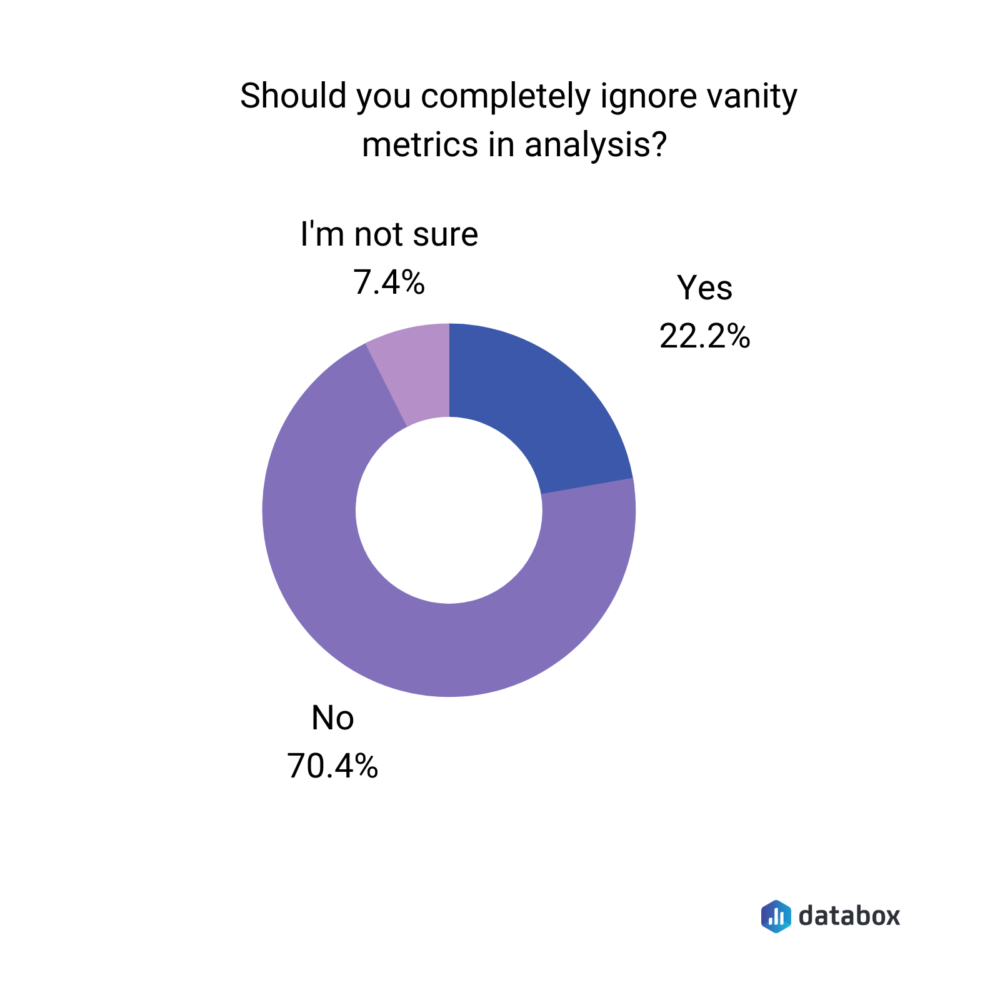In a B2B company, anything that doesn't relate directly to customer acquisition, retention, or revenue, might run the risk of being a vanity metric.

Now, that doesn't mean you're meticulously combing your hair as you're figuring out your newsletter subscribers. Or even painting your fingernails a dashing shade of blue while seeking out your page views. Instead, a vanity metric is only really there to make you look good, not report that you're actually doing good. But damn, that blue nail polish makes you look good.
Basically, vanity metrics reflect effort over impact. They don't tend to lead to conversions or sales, which is your ultimate goal.
It might be something like social media follows, blog traffic, email open rates etc. etc. They're fun and easy numbers to chase, but in the end, they aren't contributing to company-wide growth, and aren't worth obsessing over. In fact, 22.2% of marketers believe vanity metrics should be completely ignored in your analysis.
This can be because vanity metrics can lead your marketing team into believing it's getting results. Instead, they'll be looking into numbers which don't provide any real information about business growth and current health.
So, it's vital that before using a metric you ask yourself this: "will this help me make a decision, and how will it help us understand and get closer to our business goals?" If the metric doesn't help you figure these out, then it might be time to drop it. But other than this, how can you identify vanity metrics?
How to Identify Vanity Metrics
We've established that vanity metrics need to be identified so your team doesn't waste time tracking stuff that doesn't help your bottom line.
Vanity metrics can be easy to obtain and measure, and give you a nice hit of instant satisfaction to see your hard work is paying off. But sometimes they can be hard to recognise.
They can differ between companies and industries, and can even change depending on your own goals and objectives. So, you need to make sure whatever data you're measuring fits a few categories. It needs to be specific, measurable, achievable, and relevant.
It might also fall into one or more of the following signs:
- Doesn't help you improve your product or business in a meaningful way
- It lacks substance
- It skips nuance and context
- Its simplistic to measure
- It's often misleading.
This is why Eric Ries warns heavily against using vanity metrics, saying:
With data, teams have an opportunity to improve their decision making over time, systematically training their intuition to conform to reality. Without it, they're just rolling the dice.
And that's why vanity metrics are dangerous.

So, let's jump into it. What are some commonly used vanity metrics, and how are companies falling into their traps? Let's find out.
Social Media Audience and Impressions
Some might be real. Some might be fake. Some might even be bought in bulk.
Although having a large social media following might suggest you're doing something right, and that you're regularly posting content people want to see, it's not always easy to know who's following you.
The intentions of your followers can be diverse, and not very clear. Are they existing customers? Are they ready to convert? Are they competitors looking for tips and tricks? Are they looking to collaborate on projects with you? Do they just follow you for periodic office dog updates?
Although having a bunch of followers might look impressive, the metric doesn't show how many people are interacting with the content, or how frequently.
As we've mentioned above, social media followers can be purchased if a brand is willing to pay, so it's more important to look at engagement metrics that measure how your audience is reacting to the content. But don't forget to keep in mind the personas of your followers, and that the audience may be made up of many. Keeping an eye on the basic numbers won't tell you any of these vital details.
But even less important than the size of your audience is the level of impressions, i.e. the number of times your content was displayed. Jacob Shwirtz from WeWork agrees, saying:
“Multiplying anything by the number of followers you have, or by an assumption of your average follower size, just doesn’t mean anything since we know that a tiny percentage of anyone’s following actually sees or cares about any given post.”
Steven Bartlett, founder of Social Chain believes that the shift from public communities, to private communities, will reduce the importance of this figure further.
(And if you're interested in hearing more from Steven, you can check him out at this year's AntiConLX Global, where he's a keynote speaker!)
He states that there's been a big shift over the last ten years, where companies have now moved from the building of public followers on Facebook, to dark social private communities. Brands that understand this, and try to capture this opportunity today, will own the future of social media, according to Steven.
But what does this mean?
“Reddit,” says Steven. “You’ve seen what's happening on Reddit at the moment in terms of communities. Discord. Discord wasn’t a thing two years ago, now all of my companies that are in this building today are moving communications over to discord.”
“I’ve got a telegram group where almost 10M people follow me, that I can text every day. There’s no middleman deciding how much reach I get there”.
People are choosing privacy, people are choosing anonymity. That’s a macro shift, he says. There's a mov from the days when every message between friends was posted on their wall, for the world to see. Brands need to understand this shift, and develop strategies that keep this development in mind, of private, close communities.
“I would love to see a brand build up their community on discord or telegram”
“So, for me, instead of having followers, who are just numbers on my Instagram, I can now tokenise my community”
So, what should you measure instead? Well, you could focus on content shares. These tell you that you've figured out what your target personas want, and what content gets them interested. They're willing to stake their personal credibility with friends and colleagues against it.
You might also consider keeping an eye on the number of conversions generated by social media. The clicks generated by your posts can be a vanity metric if these clicks aren't converting visitors into customers. So, make sure that some of your posts are directing them to pages where they can complete a form.
Share of Voice
This is a metric which measures how frequently your brand is measured in comparison to its competitors. Sounds great right? In fact, this metric is often used to understand brand awareness, trustworthiness, and audience preference.
But it's not all sunshine and rainbows. First of all, it's not something that can be easily tracked without expensive tools, and even then it's not entirely accurate. A company might get a bunch of different outcomes, from a bunch of different teams, from a bunch of different internal calculations, and from a bunch of different tools.
So, it's this inaccuracy which causes share of voice to fall into the 'vanity metrics' category.
Without a standard definition or methodology for what counts as a 'mention', this metric is shaky. Does a retweet count? A LinkedIn post? A news article without a backlink?
Plus, this doesn't take into account whether the mention is positive, or negative. Nor does it note whether the site is sketchy or of high authority. Without sentiment analysis, the share of voice analysis doesn't function as intended.
Consider instead figuring out your brand awareness through channels such as social listening and monitoring the quality of the mention, over the quantity.
Email Open Rate
When email works, it really works. In fact, email generates $42 for every $1 spent which is an astounding 4,2000% ROI.
Plus, 4 out of 5 marketers said they’d rather give up social media than email marketing, and 89% of marketers use email as the primary channel for generating leads.
So, it's vital to understand what works in an email, and what doesn't. It's pretty easy to find out whether an email has been delivered, or whether the reader has engaged with the links or content featured.
But what's harder to prove is whether it's actually been opened, or even if it's been looked at.
Thanks to Apple's latest iOS privacy changes, this understanding is even more difficult than ever.
The new Mail Privacy Protection feature allows users to be given a choice on whether they want to select this service, and if chosen, the feature will prevent senders from knowing when recipients open an email. It'll even mask their IP address so it can't be linked to other online activity, to be used to determine their location. Think about turning your read receipts off, on a B2B scale.
So, the email is opened by a machine before it's opened by the user. The feature will also block forward tracking, so you can't find out whether a reader is forwarding your emails on either.
But why does this affect open rates? Well, if a large number of your customers are using the Privacy setting, and Apple reports that there's a 100% open rate for these individuals, then your open rate will be incorrectly inflated. This means open rates have become a heck of a lot less reliable.
Plus, open rates don't prove someone has read the content or taken any message from the content.
So, while open rates have their own merits, it isn't one to dwell on. It can highlight the effectiveness of your subject lines and time sent, but it just doesn't provide enough information on its own.
Although it might be suggested that the open rates can only track how interesting the subject line is, the email may not deliver on expectations set by a click-bait heading. A weak subject line might even drive a better response or conversion rate.
Having a high open rate doesn't hint at interest, and definitely doesn't guarantee someone's going to buy from you. Instead, you might look into the click-through rate of your email campaigns.
Having a high click-through rate suggest your followers are interested in the content you're promoting, whereas a low click-through rate hints that you're targeting the wrong people, or your content isn't compelling enough.
Microsoft's Solution to Vanity Metrics
So, Microsoft. You might've heard of them. Big deal in the entertainment media and hardware industry, where vanity metrics run rampant.
This led to Microsoft publicly moving away from a common vanity metric of console hardware sales. So, instead of reporting on what the running total of Xbox sales was, they replaced it with reports on the monthly active users of the Xbox Live service.
This is because the running total of console sales would never go down, and was tied to a one-time sale, rather than the recurring service subscription sales.
Plus, with console sales, there was no way to tell between an actively used console, and a console collecting dust in a cupboard.
Xbox’s Phil Spencer said about the change, "The nice thing about us selling consoles is your console install base will always go up. But that's not really a reflection of how healthy your ecosystem is. We focus on the monthly active user base because we know those are [people] making a conscious choice to pick our content, our games, our platform, our service. We want to gauge our success on how happy and engaged those customers are.”
